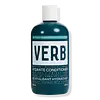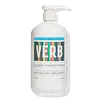What's inside
What's inside
 Key Ingredients
Key Ingredients

 Benefits
Benefits

 Concerns
Concerns

 Ingredients Side-by-side
Ingredients Side-by-side

Behentrimonium Methosulfate
Cetearyl Alcohol
EmollientIsopropyl Palmitate
EmollientPyrus Malus Fruit Extract
Skin ConditioningArgania Spinosa Kernel Oil
EmollientOrbignya Oleifera Seed Oil
EmollientCeramide NP
Skin ConditioningSqualane
EmollientEthylhexyl Olivate
Skin ConditioningPanthenol
Skin ConditioningEthylhexylglycerin
Skin ConditioningGlycerin
HumectantLauryl/Myristyl Polyricinoleate
EmollientC11-13 Isoparaffin
SolventPolyquaternium-37
Propylene Glycol Dicaprylate/Dicaprate
EmollientTrisodium Ethylenediamine Disuccinate
Guar Hydroxypropyltrimonium Chloride
Skin ConditioningCetrimonium Chloride
AntimicrobialSteartrimonium Chloride
PreservativePPG-1 Trideceth-6
Skin ConditioningCitric Acid
BufferingParfum
MaskingIsopropyl Alcohol
SolventMyristyl Alcohol
EmollientArachidyl Alcohol
EmollientSodium Benzoate
MaskingPhenoxyethanol
PreservativeBenzyl Salicylate
PerfumingBehentrimonium Methosulfate, Cetearyl Alcohol, Isopropyl Palmitate, Pyrus Malus Fruit Extract, Argania Spinosa Kernel Oil, Orbignya Oleifera Seed Oil, Ceramide NP, Squalane, Ethylhexyl Olivate, Panthenol, Ethylhexylglycerin, Glycerin, Lauryl/Myristyl Polyricinoleate, C11-13 Isoparaffin, Polyquaternium-37, Propylene Glycol Dicaprylate/Dicaprate, Trisodium Ethylenediamine Disuccinate, Guar Hydroxypropyltrimonium Chloride, Cetrimonium Chloride, Steartrimonium Chloride, PPG-1 Trideceth-6, Citric Acid, Parfum, Isopropyl Alcohol, Myristyl Alcohol, Arachidyl Alcohol, Sodium Benzoate, Phenoxyethanol, Benzyl Salicylate
Water
Skin ConditioningGlycerin
HumectantButyrospermum Parkii Butter
Skin ConditioningDimethicone
EmollientStearyl Alcohol
EmollientCetyl Alcohol
EmollientBehentrimonium Chloride
PreservativeSorbitol
HumectantStearamidopropyl Dimethylamine
EmulsifyingAmodimethicone
Hydrogenated Castor Oil/Sebacic Acid Copolymer
EmollientHydrogenated Palm Oil
EmollientHydrogenated Hemp Seed Oil
EmollientPEG-7 Glyceryl Cocoate
EmulsifyingPhenyl Trimethicone
Skin ConditioningPrunus Persica Kernel Oil
EmollientRosa Canina Fruit Oil
EmollientHydrolyzed Vegetable Protein Pg-Propyl Silanetriol
Skin ConditioningCaprylyl 2-Glyceryl Ascorbate
AntioxidantCystine Bis-Pg-Propyl Silanetriol
Skin ConditioningParfum
MaskingSqualane
EmollientQuaternium-80
Cetrimonium Chloride
AntimicrobialIsopropyl Alcohol
SolventCitric Acid
BufferingTrideceth-12
EmulsifyingHydroxyethylcellulose
Emulsion StabilisingCaprylyl Glycol
EmollientPolyquaternium-10
Chlorphenesin
AntimicrobialPolyquaternium-67
Mannitol
HumectantXylitylglucoside
HumectantAnhydroxylitol
HumectantMyristyl Alcohol
EmollientPropylene Glycol
HumectantXylitol
HumectantSodium Acetate
BufferingDisodium EDTA
Potassium Sorbate
PreservativeSodium Chloride
MaskingCellulose
AbsorbentLactic Acid
BufferingEthylhexylglycerin
Skin ConditioningPhenoxyethanol
PreservativeButylphenyl Methylpropional
PerfumingHydroxycitronellal
PerfumingLimonene
PerfumingLinalool
PerfumingWater, Glycerin, Butyrospermum Parkii Butter, Dimethicone, Stearyl Alcohol, Cetyl Alcohol, Behentrimonium Chloride, Sorbitol, Stearamidopropyl Dimethylamine, Amodimethicone, Hydrogenated Castor Oil/Sebacic Acid Copolymer, Hydrogenated Palm Oil, Hydrogenated Hemp Seed Oil, PEG-7 Glyceryl Cocoate, Phenyl Trimethicone, Prunus Persica Kernel Oil, Rosa Canina Fruit Oil, Hydrolyzed Vegetable Protein Pg-Propyl Silanetriol, Caprylyl 2-Glyceryl Ascorbate, Cystine Bis-Pg-Propyl Silanetriol, Parfum, Squalane, Quaternium-80, Cetrimonium Chloride, Isopropyl Alcohol, Citric Acid, Trideceth-12, Hydroxyethylcellulose, Caprylyl Glycol, Polyquaternium-10, Chlorphenesin, Polyquaternium-67, Mannitol, Xylitylglucoside, Anhydroxylitol, Myristyl Alcohol, Propylene Glycol, Xylitol, Sodium Acetate, Disodium EDTA, Potassium Sorbate, Sodium Chloride, Cellulose, Lactic Acid, Ethylhexylglycerin, Phenoxyethanol, Butylphenyl Methylpropional, Hydroxycitronellal, Limonene, Linalool
Ingredients Explained
These ingredients are found in both products.
Ingredients higher up in an ingredient list are typically present in a larger amount.
This ingredient is a preservative, antimicrobial, and emulsifier. It is often used in cosmetics for its ability to cleanse, condition, and reduce static.
Cetrimonium chloride is a quaternary ammonium salt, meaning it has a water-soluble structure.
Citric Acid is an alpha hydroxy acid (AHA) naturally found in citrus fruits like oranges, lemons, and limes.
Like other AHAs, citric acid can exfoliate skin by breaking down the bonds that hold dead skin cells together. This helps reveal smoother and brighter skin underneath.
However, this exfoliating effect only happens at high concentrations (20%) which can be hard to find in cosmetic products.
Due to this, citric acid is usually included in small amounts as a pH adjuster. This helps keep products slightly more acidic and compatible with skin's natural pH.
In skincare formulas, citric acid can:
While it can provide some skin benefits, research shows lactic acid and glycolic acid are generally more effective and less irritating exfoliants.
Most citric acid used in skincare today is made by fermenting sugars (usually from molasses). This synthetic version is identical to the natural citrus form but easier to stabilize and use in formulations.
Read more about some other popular AHA's here:
Learn more about Citric AcidEthylhexylglycerin (we can't pronounce this either) is commonly used as a preservative and skin softener. It is derived from glyceryl.
You might see Ethylhexylglycerin often paired with other preservatives such as phenoxyethanol. Ethylhexylglycerin has been found to increase the effectiveness of these other preservatives.
Glycerin is already naturally found in your skin. It helps moisturize and protect your skin.
A study from 2016 found glycerin to be more effective as a humectant than AHAs and hyaluronic acid.
As a humectant, it helps the skin stay hydrated by pulling moisture to your skin. The low molecular weight of glycerin allows it to pull moisture into the deeper layers of your skin.
Hydrated skin improves your skin barrier; Your skin barrier helps protect against irritants and bacteria.
Glycerin has also been found to have antimicrobial and antiviral properties. Due to these properties, glycerin is often used in wound and burn treatments.
In cosmetics, glycerin is usually derived from plants such as soybean or palm. However, it can also be sourced from animals, such as tallow or animal fat.
This ingredient is organic, colorless, odorless, and non-toxic.
Glycerin is the name for this ingredient in American English. British English uses Glycerol/Glycerine.
Learn more about GlycerinIsopropyl Alcohol is more commonly known as rubbing alcohol. It is most commonly used as a solvent, meaning it helps other ingredients dissolve.
This ingredient is an astringent alcohol. Astringent alcohols may also irritate skin as they high amounts may strip away your skin's natural oils.
Other types of astringent alcohols include:
According to the National Rosacea Society based in the US, you should be mindful of products with these alcohols in the top half of ingredients.
Any type of sanitizing product will have high amounts of alcohol to help kill bacteria and viruses.
Learn more about Isopropyl AlcoholMyristyl Alcohol is type of fatty alcohol. It is a white, waxy solid and insoluble in water.
As an emollient, it hydrates the skin by trapping moisture in.
Fatty Alcohols are most often used as an emollient or to thicken a product. They are usually derived from natural fats and oils and therefore do not have the same drying or irritating effect as solvent alcohols.
Learn more about Myristyl AlcoholParfum is a catch-all term for an ingredient or more that is used to give a scent to products.
Also called "fragrance", this ingredient can be a blend of hundreds of chemicals or plant oils. This means every product with "fragrance" or "parfum" in the ingredients list is a different mixture.
For instance, Habanolide is a proprietary trade name for a specific aroma chemical. When used as a fragrance ingredient in cosmetics, most aroma chemicals fall under the broad labeling category of “FRAGRANCE” or “PARFUM” according to EU and US regulations.
The term 'parfum' or 'fragrance' is not regulated in many countries. In many cases, it is up to the brand to define this term.
For instance, many brands choose to label themselves as "fragrance-free" because they are not using synthetic fragrances. However, their products may still contain ingredients such as essential oils that are considered a fragrance by INCI standards.
One example is Calendula flower extract. Calendula is an essential oil that still imparts a scent or 'fragrance'.
Depending on the blend, the ingredients in the mixture can cause allergies and sensitivities on the skin. Some ingredients that are known EU allergens include linalool and citronellol.
Parfum can also be used to mask or cover an unpleasant scent.
The bottom line is: not all fragrances/parfum/ingredients are created equally. If you are worried about fragrances, we recommend taking a closer look at an ingredient. And of course, we always recommend speaking with a professional.
Learn more about ParfumPhenoxyethanol is a preservative that has germicide, antimicrobial, and aromatic properties. Studies show that phenoxyethanol can prevent microbial growth. By itself, it has a scent that is similar to that of a rose.
It's often used in formulations along with Caprylyl Glycol to preserve the shelf life of products.
Squalane is an emollient that helps the skin hold onto moisture. It's an oily liquid that occurs naturally in certain types of fish and plant oils.
Because squalane boosts hydration in the skin, it also comes with plenty of benefits: it is an antioxidant and can help fight free radicals and skin damage. Squalane is also found to have a detoxifying effect when applied.
Squalane comes from squalene, which occurs naturally within the sebum of our skin. It is one of the oils our skin produces to keep itself hydrated. Squalane is the hydrogenated version of squalene and has a longer shelf life.
Research shows that squalane is non-irritating (even at 100% concentration).
In general, it's a fantastic ingredient. It does a great job at hydrating the skin, and it's suitable for those with sensitive skin.
The source of squalane may impact malassezia / fungal acne. This is because olive oil derived squalane can contain impurities such as fatty acids and plant waxes. Sugarcane derived squalane is recommended for anyone with malassezia concerns.
Is squalane vegan?
This depends on the source. Squalane can be derived from both plants and animals. Most squalane used in skincare comes from plants.
Please note: the source of squalane is only known if disclosed by the brand. We recommend reaching out to the brand if you have any questions about their squalane.
Read more about squalene with an "e".
Is squalane an oil?
Squalane is often called an oil, but it’s technically not; it’s a hydrocarbon, meaning it’s only made of carbon and hydrogen, unlike true oils which are triglycerides made of fatty acids and glycerol.
The term “oil-free” isn’t regulated, so companies can define it however they want. Some exclude all oils, while others just avoid mineral oil or comedogenic oils.
While some people avoid oils thinking they cause breakouts, the right kind of oil (or oil-like ingredient like squalane) can actually help balance and hydrate your skin. It’s worth testing out simple oils or squalane to see what works best for your skin.
Learn more about Squalane